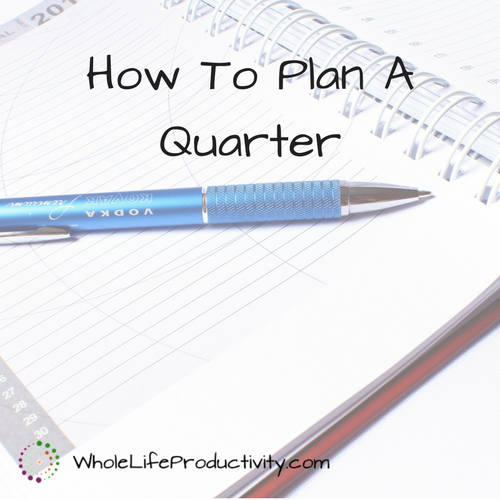
How to Plan A Quarter
One quarter. Twelve weeks. Three months. One season. It’s easier to get a feel for how much you can get done in this time frame because it is something you can internalize. So today we’ll take the general planning instructions from How To Plan Any Time Span and apply them to a quarter.
When I first started learning about productivity, I was advised to set a mission statement and then determine my 5- and 10-year goals. At the time this seemed impossible; I was very young and I had no idea what I wanted to be doing in those time frames. I figured it would get easier as I got older.
This wasn’t the case. I’ve never successfully planned 5- or 10-year goals. And if you want the absolute truth, I don’t do well with 1-year goals, either. The problem is that the time frame is too long. I can’t see the end of it, so there is no urgency. I can’t get a sense of the time involved, so I choose to do far too much. And in the end, I do very little.
So my planning revolves around quarters. Today I’ll give you the high-level overview of how I do it.
Want to make it easier? I have a course that will make planning a quarter easy. Get information here.
In the article How To Plan Any Timeframe, I went over the general steps to plan any time frame. I’m going to use them to show you how to play out a quarter.
The Planning Steps
Step 1: have some way to write this plan down.
When you’re planning for a quarter, you’re going to need more than a single piece of paper to write this down. I use the 12 planner I designed (yes, I use my own products!). However, you can do this in a notebook, or in a Word document.
The key is that you have to write it down. 12 weeks is too long to remember the details of what you were thinking.
Step 2: write in your commitments.
The first thing I do is look at all the things that are on my calendar for the next 12 weeks. This includes major holidays, events like National Novel Writing Month, vacations and other big projects I have committed to. I list all of them out, in order by the date that they occur or when they are due. If it is a span of time, I write the start and end dates down.
I add these events all to blank calendar grids. This gives me a way to see what is happening overall, and also serves as a reminder as I plan out the individual weeks.
Once these items are down, I look at the things that typically happen every week. This would be appointments like choir rehearsals, dinner with the girls, and Girl Scout meetings.
Step 3: look at the shoulds.
I have a set of life maintenance items that occur weekly, monthly and seasonally. These are all in my task manager, so I pull out all of the things that are due in the 12 weeks in question.
But what if you don’t have a task manager list already set? Pull out a piece of paper, and list first everything you do daily. This would be things like cooking, cleaning, doing the dishes.
Next, add those things that you do weekly, such as laundry, paying the bills, yard work, etc.
Then add those things that you do monthly, like home maintenance chores, heavy cleaning and such.
Finally, look back at the list of items you put together that will be happening in the 12 week period, and write down all of the tasks associated with those. For instance, if you have a vacation coming up, this would include planning, packing, scheduling pet boarding, and vacation mail service.
Step 4: estimate the time.
Time estimation is a skill that is learned through practice. If you have never done this before, don’t be discouraged if you aren’t very good at it.
For each of the tasks in Step 3, do a time estimate. Make sure you add in travel time, such as transit to and from the grocery store.
The point of this step is to get an idea of how much free time you would have for your dreams and non-should projects, so be as accurate as you can.
Step 5: remove tasks if necessary from the should list.
There are two truths: no one dies with an empty task list; and work expands to fill all available time.
Chances are your should list is going to fill all of your free time. So now you have to make choices. What are you going to commit to doing, and what can you let go? What can you delegate? What can you hire out? What can you just drop?
Go through the list and start load-balancing.
Step 6: pick some wants.
Next, pick two to three projects to accomplish during the quarter. If they are bigger than a quarter (such as lose 50 pounds), break them down into something that could be done in 12 weeks.
You should aim for no more than 4 items, and only 4 if they are smallish. Figure out what you want to accomplish, and the steps it will take to get there.
Next, decide when in the 12 weeks you will do these steps. Yes, I mean put them on your task list with dates and everything. Otherwise they will remain dreams. Committing to doing the work is how you will get the items done.
Step 7: estimate the time.
Next, estimate the time on those tasks you have put in place. This is just like estimating the tasks from the should list. The point is to get an idea of how long you will spend.
If you don’t know, because you have never done something like this before, do some research. Ask someone who has done this. Or look at a similar task that you have done before.
Step 8: remove tasks if necessary from the want list.
If you have done all your tasks, look at the overall time it will take. Remember that you only have 24 hours in the day. If you are overloaded, either dump some should tasks, or scale back your want tasks. Either way, make sure that you have adequate time to relax and rejuvenate each week.
By applying the planning framework, you can plan a 12 week period that will get you much closer to your goals, while working around the already set events of your life.
Want to make it easy? Check out my 12 Week Year Planning course.




